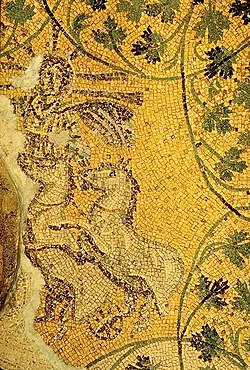| Revision as of 17:09, 12 August 2021 editKarma1998 (talk | contribs)Extended confirmed users13,019 edits UnsourcedTags: Visual edit Mobile edit Mobile web edit Advanced mobile edit← Previous edit | Revision as of 17:32, 9 April 2022 edit undoRuedi33a (talk | contribs)Extended confirmed users19,312 edits Add infobox building to activate mapframeNext edit → | ||
| Line 1: | Line 1: | ||
| {{Short description|Part of the Vatican Necropolis}} | {{Short description|Part of the Vatican Necropolis}} | ||
| {{Infobox building | |||
| ⚫ | {{coord|41|54|8|N|12|27|12|E|display= |
||
| |name=Tomb of the Julii | |||
| |image=Christus Sol Invictus.jpeg | |||
| |caption=Detail of the mosaic | |||
| |coordinates= | |||
| ⚫ | {{coord|41|54|8|N|12|27|12|E|display=it}} | ||
| |location=] | |||
| |mapframe=yes | |||
| |mapframe-caption=Click on the map for a fullscreen view | |||
| |mapframe-zoom=14 | |||
| |mapframe-marker=cemetery | |||
| }} | |||
| The popularly named "'''Tomb of the Julii'''" (Mausoleum "M") survives in the ] beneath ]. The serendipitous discovery near the ] has a vaulted ceiling bearing a ] depicting ] (Roman ]) with an ] riding in his chariot, within a framing of rinceaux of vine leaves. The mosaic is dated to the late 3rd century to early 4th century. Other mosaics in this tomb depicting Jonah and the whale, the good shepherd carrying a lamb (the '']'' motif), and fishermen have encouraged its interpretation as a Christian tomb. | The popularly named "'''Tomb of the Julii'''" (Mausoleum "M") survives in the ] beneath ]. The serendipitous discovery near the ] has a vaulted ceiling bearing a ] depicting ] (Roman ]) with an ] riding in his chariot, within a framing of rinceaux of vine leaves. The mosaic is dated to the late 3rd century to early 4th century. Other mosaics in this tomb depicting Jonah and the whale, the good shepherd carrying a lamb (the '']'' motif), and fishermen have encouraged its interpretation as a Christian tomb. | ||
Revision as of 17:32, 9 April 2022
Part of the Vatican Necropolis| Tomb of the Julii | |
|---|---|
 Detail of the mosaic Detail of the mosaic | |
| Click on the map for a fullscreen view | |
| General information | |
| Location | Vatican City |
| Coordinates | 41°54′8″N 12°27′12″E / 41.90222°N 12.45333°E / 41.90222; 12.45333 |
The popularly named "Tomb of the Julii" (Mausoleum "M") survives in the Vatican Necropolis beneath St. Peter's Basilica. The serendipitous discovery near the crypt has a vaulted ceiling bearing a mosaic depicting Helios (Roman Sol Invictus) with an aureole riding in his chariot, within a framing of rinceaux of vine leaves. The mosaic is dated to the late 3rd century to early 4th century. Other mosaics in this tomb depicting Jonah and the whale, the good shepherd carrying a lamb (the kriophoros motif), and fishermen have encouraged its interpretation as a Christian tomb.
This tomb was first discovered in 1574 AD when workmen accidentally broke through the ceiling while conducting some floor alterations in the basilica. The inside was briefly explored and documented before the opening was sealed over once more.
See also
References
- Beckwith, John 1979. Early Christian and Byzantine Art (Yale University Press): 19
- Perler, Othmar 1953, Die Mosaiken der Juliergruft im Vatikan (Universitätsverlag): 34–36
- Walsh, John Evangelist. The Bones of Saint Peter (The Chaucer Press): 15
- Specific
- The Bones of Saint Peter, John Evangelist Walsh 1982
Further reading
- Weitzmann, Kurt, ed., Age of spirituality: late antique and early Christian art, third to seventh century, no. 467, 1979, Metropolitan Museum of Art, New York, ISBN 9780870991790